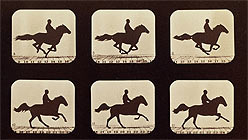The legend goes: In 1872, Leland Stanford, the governor of California, made a bet with photographer Eadwaerd Muybridge. Stanford believed that a horse at full gallop always had at least one hoof touching the ground; using stop motion photography to capture the motion at a hundredth of a second, Muybridge proved the governor wrong. Even more importantly, his finished work was not the singular photograph of the floating horse, but all of the images that came before and after that moment of suspension. With this single exercise, photography evolved beyond the fixed document, exploding into a dynamic world of serial motion. As Rebecca Solnit wrote in her 2003 book, River of Shadows (one the best existing on Muybridge), “He is the man who split the second, as dramatic and far-reaching an action as the splitting of the atom.”
The San Francisco Museum of Modern Art’s new exhibition Helios: Eadweard Muybrudge in a Time of Change was organized by the Corcoran Gallery in Washington DC, but feels at home in Northern California. Muybridge was English-born, but spent most of his life in and around San Francisco. Along with shooting romantic images of the western landscape, he photographed every major landmark of the city: our parks, churches and docks. His cityscapes include many 360-degree cosmopolitan panoramas. (His most famous, “Panorama of San Francisco, From California St. Hill,” from 1877, was produced using eleven negative plates and took Muybridge five hours to create.) As dozens of moderate earthquakes wreaked their havoc on a still relatively vulnerable city, Muybridge captured the urban environment forever in the midst of being rebuilt. (He died just two years short of the Great Earthquake of 1906.) Look closely for the piles of dirt and rubble, waiting to be excavated and developed, on near every city block. His pioneering process of seaming together multiple viewpoints to fabricate one image reflects the spirit of technological innovation that was summoned in reconstituting the modern city itself.

“Boxing; open-hand. Plate 340,” Eadweard Muybridge, 1887, Corcoran Gallery of Art, Washington, D.C.
Muybridge’s greatest contribution to the history of photography and film, and the work for which he is most renowned, are his stop-motion images of humans and animals in action. Though we surely take it for granted now, Muybridge was the first to harness stillness to describe, unpack, and implicate the properties of motion. Progressively sequencing his images in grids, the viewer witnesses women bathing one another, men boxing, animals trotting, and much more. Whether intended or not, these prolific images occupy a certain humor and strangeness, as they are full of both bizarre and banal activities, ranging from a bending contortionist to women in long dresses jumping over stools. Even beyond Muybridge’s fascination with the technological capacity of the medium, these specific actions and gestures embody great depth and curiosity. Simultaneously animated and still, these sequences are our original motion pictures.

“First-Order Lighthouse at Punta de los Reyes, Seacoast of California, 296 Feet Above Sea (4136),” Eadweard Muybridge, 1872, San Francisco Museum of Modern Art; gift of Jeffrey Fraenkel and Frish Brandt.



